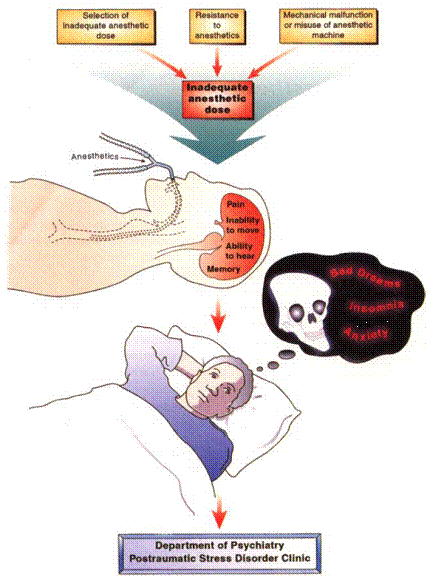|
Unintended
intraoperative awareness occurs during general anesthesia when a patient
regains consciousness and becomes cognizant of certain events occurring
during surgery or a procedure and has recall of some or all of those
events. Serious, and potentially disabling, psychological injury may result
in some patients who experience intraoperative awareness.
Incidence
The
frequency of anesthesia awareness has been found in multiple studies to
range between 0.1% - 0.2% of adult patients undergoing general
anesthesia. While few studies related to awareness have been conducted
in the pediatric population, it appears that the rate may be similar to or
higher than that of adults.
The incidence of awareness is increased in certain clinical situations,
including specific types of surgery, patients, and anesthesia techniques.
In these clinical situations, the incidence of unintended awareness may be
closer to 1% - a risk of 1 patient in 100.
Causes
A variety of etiologies have been reported to cause episodes of
anesthesia awareness. Generally, insufficient anesthetic effect (thus
allowing a state of consciousness that permits memory formation) results
from inadequate dosing or delivery of the primary anesthetic agent.
Inadequate dosing presumably would include situations where low
concentrations are selected in response to the patientís conditions (e.g.,
hypotension), inadvertent paralysis of an awake patient, as well as in
situations where a patient may have a larger-than-expected anesthetic
requirement. Inadequate delivery of anesthetic agents may result from any
failure or misuse of anesthesia equipment that is vital to agent administration.
Such equipment includes the anesthesia machine, vaporizer, airway
management device, breathing circuit, infusion pump, intravenous line and
catheter.
In a root-cause analysis of 81 cases of intraoperative awareness, three
primary categories were identified. In 44% of the events, awareness was
felt to be due to low inspired volatile agent concentration or inadequate
hypnosis. In 40% of cases, a drug error led to inadvertent paralysis of an
awake patient. Finally, in 16% of patients, the awareness incident had no
obvious cause.
Consequences
Patients who experience awareness may recall hearing operative sounds
and voices or may experience the sensation of not being able to move or
breathe, pain, or panic. While not every episode of intraoperative awareness
is associated with negative recollections, it appears that over 50% of
these patients experience some degree of mental distress during or
following an awareness episode. Prolonged psychological effects may include
intrusive thoughts, nightmares, and in some patients, development of
post-traumatic stress disorder. The need for prolonged psychological or
psychiatric care may be in the range of 40-60% following traumatic
awareness episodes. In some situations, patients who claim to have no
after-effects of an awareness episode in the early postoperative period may
still be at risk for developing subsequent psychological disability. Prompt
identification and appropriate psychological management of patients who
experience awareness is felt to minimize these complications.

How Can We Prevent Awareness?
Historically, and still the most commonly used technique, is simply to
administer anesthetics at relative overdose concentrations. The progressive
development of shorter acting and more titratable anesthetics and potent
analgesics has greatly facilitated this phenomenon. A refinement of
this approach has been the development of ways to monitor end tidal
anesthetic concentration and thereby estimate the brain
concentration. The development and popularization of pharmacokinetic
models of intravenous anesthetic administration have similarly facilitated
this approach whereby population based models are used to estimate the
amount of drug required. However, none of the above approaches guarantees
that every individual is adequately anesthetized. Hence the desire
for objective monitors. Furthermore, there is the hope that such
monitors would not only prevent awareness but would also result in cost
saving by greatly limiting the use of drug overdose as a management
strategy.
.
|